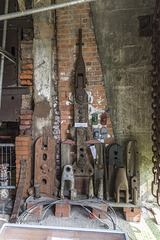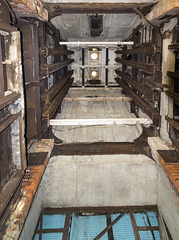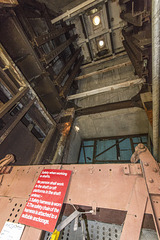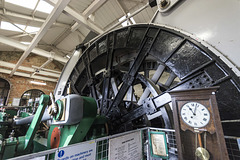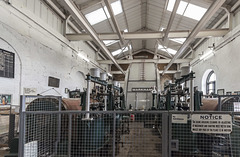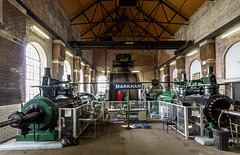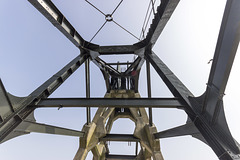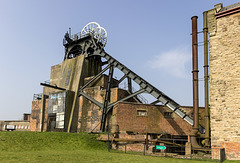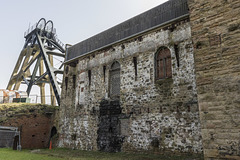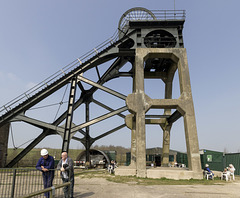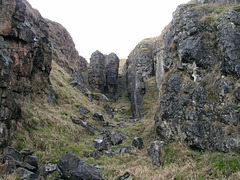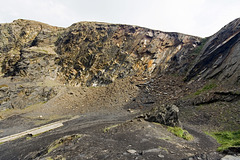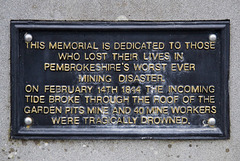
Mines, mining and quarrying
Folder: Mining and quarrying
Capels and detaching hook
| |
|
An exhibit of capels (the cone-shaped shackle-like objects) at Pleasley Colliery mining museum. The tall object to the rear is a cage capel used for attaching the winding rope to the chains linking to the top of the cage. Below the capel is a detaching hook mechanism which was designed to detach the winding rope from the cage in the event of an over-wind. This prevented the cage being drawn up through the top of the shaft and into the pulleys. A cage arrestor device (not shown here) then caught the detached cage and prevented it falling back down the shaft.
The capel was attached to the steel winding rope by splaying out the various strands of the rope into the interior of the capel cone and filling up the space with molten white metal - an alloy of lead, antimony and tin.
Pleasley Colliery is situated just inside the Derbyshire border, about 5.5 km from the centre of Mansfield, Nottinghamshire. It is now a mining museum which is steadily being developed.
www.pleasleypittrust.org.uk
Pleasley Colliery No.2 South Shaft top area
| |
|
The interior of the shaft top area of No.2 South Shaft at Pleasley Colliery. This was formerly the upcast shaft where air and mine gases were drawn up the shaft by the ventilation fan from the mine workings below. The shaft sides were encased by a concrete and brick structure in order to stop outside air from short-circuiting the ventilation system. Entry to the shaft area was via a pair of air-lock doors. Men and materials were mostly wound at this shaft; coal was wound at the No.1 downcast shaft.
The posters and signboards on the walls and superstructure form part of the current museum exhibit and do not necessarily represent the view of the area as it was during the working life of the mine.
Pleasley Colliery is situated just inside the Derbyshire border, about 5.5 km from the centre of Mansfield, Nottinghamshire. It is now a mining museum which is steadily being developed.
www.pleasleypittrust.org.uk
Pleasley Colliery No.2 South Shaft interior 2
| |
|
An interior view looking up into the No.2 South shaft at Pleasley Colliery. This was formerly the upcast shaft where air and mine gases were drawn up the shaft by the ventilation fan from the mine workings below. The shaft sides were encased by a concrete and brick structure in order to stop outside air from short-circuiting the ventilation system. Entry to the shaft area was via a pair of air-lock doors.
The two holes in the roof are where the winding ropes used to come through. The notched steel rails on each side form part of the cage arrestor mechanism to capture the cage and stop it falling back down the shaft in the event of an over-wind.
Pleasley Colliery is situated just inside the Derbyshire border, about 5.5 km from the centre of Mansfield, Nottinghamshire. It is now a mining museum which is steadily being developed.
www.pleasleypittrust.org.uk
Pleasley Colliery No.2 South Shaft interior view
| |
|
An interior view looking up into the No.2 South shaft at Pleasley Colliery. This was formerly the upcast shaft where air and mine gases were drawn up the shaft by the ventilation fan from the mine workings below. The shaft sides were encased by a concrete and brick structure in order to stop outside air from short-circuiting the ventilation system. Entry to the shaft area was via a pair of air-lock doors.
The two holes in the roof were where the winding ropes entered the shaft top.
Pleasley Colliery is situated just inside the Derbyshire border, about 5.5 km from the centre of Mansfield, Nottinghamshire. It is now a mining museum which is steadily being developed.
www.pleasleypittrust.org.uk
Pleasley Colliery No.1 winding engine drum
| |
|
The winding drum of the No.1 North Shaft winding engine at Pleasley Colliery. The winding engine has been restored to working condition.
Pleasley Colliery is situated just inside the Derbyshire border, about 5.5 km from the centre of Mansfield, Nottinghamshire. It is now a mining museum which is steadily being developed.
www.pleasleypittrust.org.uk
Pleasley Colliery No.1 winding engine
| |
|
The interior of the No.1 North Shaft winding house and the Markham winding engine at Pleasley Colliery. The winding engine has been restored to working condition.
Pleasley Colliery is situated just inside the Derbyshire border, about 5.5 km from the centre of Mansfield, Nottinghamshire. It is now a mining museum which is steadily being developed.
www.pleasleypittrust.org.uk
Pleasley Colliery No.2 shaft winding engine
| |
|
The interior of the No.2 South shaft winding house and the Markham winding engine at Pleasley Colliery. The winding engine is currently being restored to working condition.
Pleasley Colliery is situated just inside the Derbyshire border, about 5.5 km from the centre of Mansfield, Nottinghamshire. It is now a mining museum which is steadily being developed.
www.pleasleypittrust.org.uk
Pleasley Colliery North Shaft headframe
| |
|
Looking up the North Shaft headframe at Pleasley Colliery. This was originally the downcast shaft where fresh air entered the mine, hence the headframe is an open lattice structure.
Pleasley Colliery is situated just inside the Derbyshire border, about 5.5 km from the centre of Mansfield, Nottinghamshire. It is now a mining museum which is steadily being developed.
www.pleasleypittrust.org.uk
Pleasley Colliery South Shaft
| |
|
The No.2 South Shaft at Pleasley Colliery. This was formerly the upcast shaft where air and mine gases were drawn up the shaft by the ventilation fan from the mine workings below. The shaft sides were encased by a concrete and brick structure in order to stop outside air from short-circuiting the ventilation system. Entry to the shaft area was via a pair of air-lock doors.
The two holes in the roof were where the winding ropes entered the shaft top.
Pleasley Colliery is situated just inside the Derbyshire border, about 5.5 km from the centre of Mansfield, Nottinghamshire. It is now a mining museum which is steadily being developed.
www.pleasleypittrust.org.uk
Pleasley North Shaft: north aspect
| |
|
The North Shaft headframe at Pleasley Colliery. This was originally the downcast shaft where fresh air entered the mine, hence the headframe is an open lattice structure.
The building houses the winding engine, fortunately still preserved and in the process of being carefully restored.
Pleasley Colliery is situated just inside the Derbyshire border, about 5.5 km from the centre of Mansfield, Nottinghamshire. It is now a mining museum which is steadily being developed.
www.pleasleypittrust.org.uk
Pleasley North Shaft headframe
| |
|
The North Shaft headframe at Pleasley Colliery. This was originally the downcast shaft where fresh air entered the mine, hence the headframe is an open lattice structure.
The shaft is now filled and capped, with a concrete plinth on the top. It is rather incongruous to see folks sitting in garden chairs enjoying a cup of coffee where once this was a busy, noisy place with tubs full of coal being wound to the surface.
Pleasley Colliery is situated just inside the Derbyshire border, about 5.5 km from the centre of Mansfield, Nottinghamshire. It is now a mining museum which is steadily being developed.
www.pleasleypittrust.org.uk
Pleasley Colliery - southern aspect.
| |
|
Pleasley Colliery is situated just inside the Derbyshire border, about 5.5 km from the centre of Mansfield, Nottinghamshire. It is now a mining museum which is steadily being developed.
www.pleasleypittrust.org.uk
Pleasley colliery
| |
|
|
A south-easterly view of Pleasley colliery from the restored spoil heap.
Pleasley Colliery is situated just inside the Derbyshire border, about 5.5 km from the centre of Mansfield, Nottinghamshire. It is now a mining museum which is steadily being developed.
www.pleasleypittrust.org.uk
'Blue Lagoon' Abereiddi, Pembrokeshire
| |
|
The 'Blue Lagoon' is the flooded lower section of an abandoned 'slate' quarry at Abereiddi bay, Pembrokeshire.
The rock is not true slate (a metamorphic rock) but thinly bedded black shales (Caerhys Shale) which span the Llanvirnian-Llandeilian junction in the Ordovician. On the right of the photo the quarry wall exposes the volcanic Abereiddi Tuff Member.
Dirtlow Rake openworks, near Castleton, Derbyshire
| |
|
Originally uploaded for the GuesswhereUK Group.
This is part of Dirtlow Rake lead vein 'openworks' where the vein has been excavated from the surface leaving a slot with walls of limestone on each side. In this particular location the vein splits into a complex of several branching and rejoining sub-parallel veins formed along a strike-slip duplex fault structure. Most of the movement along the faults was near-horizontal as evidenced by horizontal slickensides (groove marks) along the vein walls.
This part of the vein has been worked since medieval times. In the floor of the opencut are numerous old shafts which accessed the deeper parts of the vein mostly from the 16th and 17th century onwards.
Abandoned 'slate' quarry, Abereiddi Bay, Pembrokes…
| |
|
Originally uploaded for the GuesswhereUK group. Photo has been replaced with slightly more extensive, uncropped version.
This is the back-wall of the abandoned 'slate' quarry, the flooded section of which is now the Blue Lagoon at Abereiddi bay, Pembrokeshire.
The rock is not true slate (a metamorphic rock) but thinly bedded black shales (Caerhys Shale) which span the Llanvirnian-Llandeilian junction in the Ordovician. Certain bedding planes towards the right-hand side are particularly rich in the graptolite zone fossil Didymograptus murchisoni .
Thousands of people each year see this, either walking past it or attending diving or coasteering (horrible word!) events in the Blue Lagoon.
Methane vent pipe near Arkwright Town, Derbyshire
| |
|
The mining village of Arkwright Town near Chesterfield, Derbyshire, experienced serious methane emissions from the ground following closure of the Arkwright Colliery drift mine in 1988. As a result, the entire community was moved into brand new properties, constructed some 200 - 600 metres away. The original village was then demolished and obliterated as part of an opencast coal mining operation in the 1990s designed to remove the old deep mine workings and associated strata which were the source of the methane emissions.
This methane vent pipe is one of a pair at this location situated on the restoration backfill of the Arkwright opencast coal mine in order to safely control residual methane emissions from the backfill and surrounding strata.
Landshipping Memorial description
Jump to top
RSS feed- Latest items - Subscribe to the latest items added to this album
- ipernity © 2007-2024
- Help & Contact
|
Club news
|
About ipernity
|
History |
ipernity Club & Prices |
Guide of good conduct
Donate | Group guidelines | Privacy policy | Terms of use | Statutes | In memoria -
Facebook
Twitter

